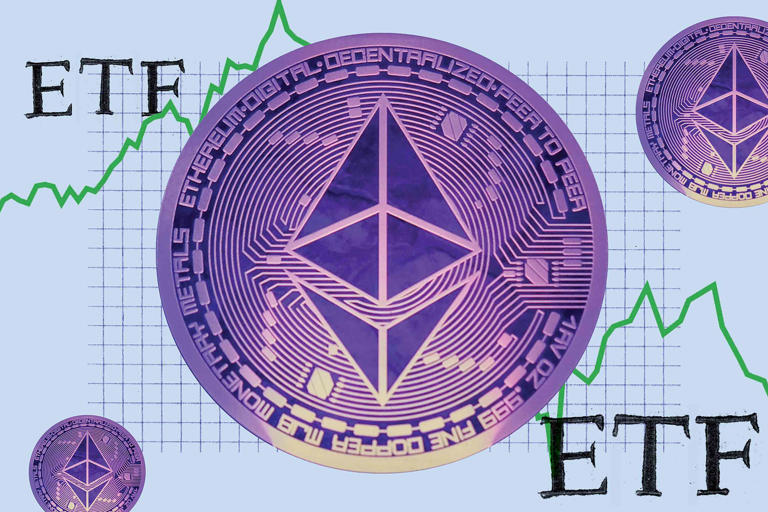The investment landscape has recently expanded with the introduction of spot exchange-traded funds (ETFs) for ether (ETH), the cryptocurrency that powers the Ethereum blockchain. On [insert date], nine new spot ether ETFs began trading, offering investors a convenient way to add ether to their portfolios through their existing brokerage accounts. This development is notable because it streamlines the investment process in a manner similar to purchasing traditional stocks and ETFs, eliminating the need for managing digital assets in separate digital wallets.
Douglas Boneparth, a Certified Financial Planner (CFP) and founder of Bone Fide Wealth, highlights the advantage of these ETFs: “Most investors are accustomed to holding securities in their brokerage accounts, and they’re unfamiliar with holding digital assets in digital wallets. By having a Bitcoin or Ethereum ETF, they can invest in these assets in a more familiar way.” This shift aligns digital asset investing with traditional financial practices, potentially broadening the appeal of cryptocurrencies to a wider range of investors.
Major brokerage firms like Fidelity and Charles Schwab have incorporated these ETFs into their offerings. Investors interested in this new investment vehicle should check with their brokers to see if they can access these ETFs through their accounts.
Initial Market Response and Investor Sentiment
The ether ETFs have garnered significant attention since their debut, attracting more than $100 million in inflows on their first trading day. However, this initial enthusiasm has not reached the levels observed with spot Bitcoin ETFs, which saw massive inflows when they were introduced earlier in the year. This disparity might reflect differing levels of investor confidence or interest in ether compared to Bitcoin, with the latter having historically attracted more attention and investment.
Volatility and Risk Considerations
Investing in cryptocurrencies, including via ETFs, is known for its high volatility. Morningstar’s analysis underscores this point, revealing that ether and Bitcoin are significantly more volatile than traditional investment portfolios. Specifically, ether and Bitcoin are, on average, six and eight times more volatile, respectively, compared to a standard 60/40 portfolio that balances equities and fixed income.
Megan Gorman, managing partner at Chequers Financial Management, emphasizes the importance of understanding the inherent risks associated with crypto ETFs. “These are funds that don’t have significant track records. There’s a lot of volatility, and people really need to get used to what these types of funds are doing in the marketplace.” This caution reflects the broader uncertainty surrounding cryptocurrencies and their potential impact on investment portfolios.
Stephen Margaria, a manager research analyst at Morningstar, elaborates on the volatility of cryptocurrencies: “These are cryptocurrencies that have had incredible returns over their respective lives, and that’s also come with a lot of volatility.” His analysis reveals that, over a five-year period, ether and Bitcoin displayed average volatility levels that were significantly higher than those of traditional portfolios, highlighting the substantial risk involved in investing in these digital assets.
Impact on Portfolio Volatility
Incorporating cryptocurrencies into a portfolio can lead to substantial increases in overall volatility. Morningstar’s analysis shows that even a modest allocation of 5% to ether, Bitcoin, or a combination of both can raise a portfolio’s volatility by more than 10% compared to a conventional 60/40 mix. The effect is more pronounced with higher allocations, underscoring the importance of understanding how cryptocurrency investments can alter overall portfolio risk.
Margaria advises that small allocations of 1% or 2% may have a minimal impact on a portfolio’s risk profile. However, significant investments of 5% or more necessitate careful consideration. “If investors want to further diversify their portfolio into crypto, at 1% or 2%, you’re not looking at much of a change in the portfolio’s risk profile, but it’s really at 5% or over that investors should be aware of how that [risk] changes,” he explains.
Conclusion
The launch of spot ether ETFs represents a significant development in the investment world, offering a new and accessible way to invest in cryptocurrencies. These ETFs simplify the process of acquiring ether by allowing investors to trade it through traditional brokerage accounts, much like other securities. However, potential investors should be aware of the increased volatility and risk associated with cryptocurrencies. While these digital assets offer the potential for high returns, they also come with substantial risks that can impact overall portfolio stability. It is crucial for investors to evaluate their risk tolerance and investment strategy carefully before incorporating substantial amounts of cryptocurrencies into their portfolios. By doing so, they can better manage the potential volatility and align their investments with their overall financial goals.
